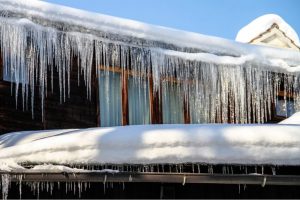How to Storm-Proof Your Roof
Sep 26, 2023

With the global temperature rising and changing yearly, we’ve been seeing a rise in severe storms alongside hotter climates and unpredictable rainfall. The scale and frequency of these big storms is unprecedented, as is the damage they’ve been leaving behind. While Canada may not have the threats of hurricanes and tsunamis the way tropical and southern regions do, we aren’t immune to strong winds, heavy rain and other weather hazards.
Homeowners may want to ensure they are prepared when it comes to Mother Nature, and fortunately, there are lots of manageable and cost-effective ways you can protect your home and roof, using a little bit of foresight. Here’s how you can storm-proof your roof in the event that there is a severe storm.
Trim Down Your Trees:
While not just something to be done in preparation for a storm, trimming your trees is a good practice to upkeep on the regular. Trees have always been one of the biggest threats to homeowners, as their looming height and weight can cause irreplaceable damage to your roof . In the event of an oncoming storm, this threat multiples. Trees with branches that are hanging low and near to your house is what you want to target, as falling limbs can cause windows to break and roofs to cave in. Long branches act like whips in harsh winds, so keeping them at least six feet away from your home is in best practice.

Trees are also quite susceptible to rotting and disease, especially from the inside. You might not notice it, but during a storm, these dead branches can easily snap and damage your roof . This type of destruction can cause severe water leakage into your home, electrical issues, and even bodily harm to anyone who might be in the tree’s falling path. Additionally, trees “shed” quite a bit – leaves, twigs, pine needles etc. If your trees are too close to your roof, they can form piles of this debris, leaving mounds of mulch on your rooftop.
Mulch is dense and retains water , meaning it can cause the shingles underneath it to deteriorate and rot, a serious cause for roof repair. Keeping your trees in good shape and away from your roof is one of the most recommended tips when it comes to storm-proofing.
Clean Out Your Gutters:
Probably one of the most loathsome chores of homeowners is cleaning out the gutters . Often overlooked or put off, gutters can easily and quickly get clogged over the course of the year. Because of this, it is of utmost importance to ensure your gutters are clear and devoid of debris and leaves. Gutters are essential drainage systems for the exterior of a house, and in the event of heavy rainfall and storming, this drainage system needs to be working in top order.

First check your gutters, and then move on to all the spouts and water flow areas. The same mulch that can accumulate on your rooftop is very often found in gutters. This mulch is heavy and wet, so removing it will ensure excess water can easily flow through.
Spot Check Your Roof:
Grab a pair of binoculars or if safe and accessible, use a ladder. Do a minor spot check to make sure all shingles are properly nailed down, check for broken or missing shingles, check for rust and erosion, curling or buckling shingles, cracked or worn boots around the pipes, or an excessive amount of shingle granule build-up in your gutters – a sign that your shingles may be on their way out. Your roofing is your first priority when it comes to storms, so hiring a professional to do a thorough check might be a good idea.

Check for Leaks:
You can easily check for leaks in your roofing yourself. If you have access to your attic, head on up there with a flashlight and look for water spots and stains, or black marks and spots from mold. This is the easiest way to discover roof leaks.
You can also hire a professional, or with some help, take a garden house up to your roof and run a low flow on the shingles. Have your helper stay inside the house to check if any water leakage appears as you soak that area of the roof. This will directly indicate to you where the leak is, if there is one.
Secure Doors and Windows:
During an intense storm, a window breakage is more than just damage to the glass. A broken window can drastically increase the pressure inside the house, enabling the roof to act like a giant parachute.
This is avoidable by making sure all doors and windows are tightly secured and locked at all times during the storm. Tying down anything that can fly away (patio furniture, toys, pool accessories) will help in making sure nothing can suddenly smash into the window.
Be ready this year by implementing these tips to storm-proof your roof and home!





